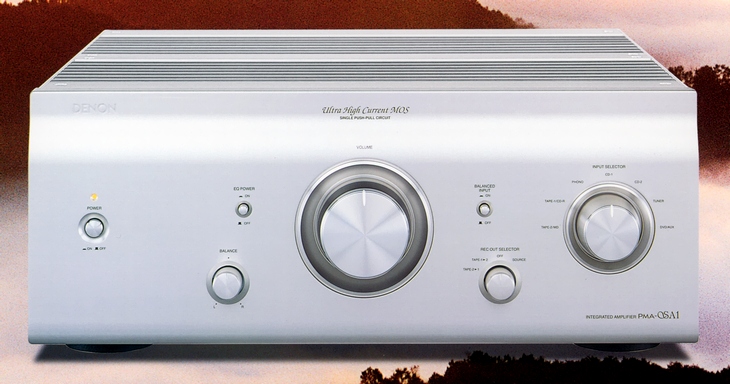
DENON PMA-SA1
¥ 660,000 (released in February 2005)
Commentary
Pre-main amplifier with UHC-MOS single push-pull circuit.
The amplifier uses UHC-MOS, which is a high-current amplifier, and has an ideal circuit configuration of a high-output single-push-pull amplifier.
The UHC-MOS has an amplification factor equal to or higher than that of a bipolar transistor, and enables current linearity equivalent to 35 conventional MOS-FETs and 3 bipolar transistors with a single element, and also has the sound reproduction capability of MOS-FETs.
UHC-MOS has a low breakdown voltage and a large junction capacitance when used alone.
In order to solve this problem and bring out stable operation and good conversion characteristics, we have adopted a cascode bootstrap connection. This keeps the voltage applied to the UHC-MOS constant and solves the problem of large junction capacitance. Temperature stability is also remarkably improved, and the acoustic characteristics of the UHC-MOS are brought out stably.
In the PMA-SA1, the cascode bootstrap connection realizes the ideal characteristics for the power amplifier stage, and the stable operation is obtained. This enables the voltage amplifier stage to be simple in structure, and ensures sound quality without coloring.
The stable operation and drive capability of the UHC-MOS eliminates the source resistance that causes the music signal to be contaminated, and the speaker is directly connected to the output stage with high drive power.
All stages are balanced amplifier configuration, and the internal voltage is kept low, making it possible to use an excellent device for constant voltage. Noise and interference between circuits are also kept low. Moreover, the output current of the speaker is isolated from the ground circuit, so that the speaker is driven only by the output stage.
It has an inverted ∑ Balance circuit that supports both balanced and unbalanced inputs.
This circuit eliminates the need for separate conversion circuits in the previous stage, and is designed to be directly input to the power stage of the balanced configuration.
The volume is a 50-inch volume for high-end audio.
It uses low-distortion carbon ink and a gold-plated multi-contact wire brush for more faithful music reproduction and accurate volume control up to a maximum attenuation of -120dB.
In addition, a brass machined case is used for the volume case to eliminate the influence of external vibration and contamination of external noise.
The power transformer is enclosed in a sand-cast case with excellent vibration isolation characteristics to reduce the effect of vibration. A sand-cast holder is also used to fix capacitors that are susceptible to vibration.
In the power supply section, the output stage, which requires a large current, and the voltage amplification stage, which requires stability, are separated from each other at the transformer winding stage. In addition, high-capacity electrolytic capacitors with low-impedance electrode foils are combined with high-quality capacitors with different frequency characteristics to improve sound quality. In addition, low-loss, low-noise, high-speed Schottky barrier diodes are used in the rectifier element to provide sufficient current supply capability and clean current supply.
In addition, control systems such as relays are separated from transformer windings to eliminate the influence on sound quality.
A low-noise FET is used in the first stage of the phono equalizer circuit.
This circuit is equipped with an independent stabilizing power supply circuit. Only the equalizer circuit can be turned on/off. When the equalizer circuit is not used, such as when playing a CD, the influence on the line input can be eliminated.
It uses a Precision Signal Ground circuit, and the control circuit operates between two positive and negative power supplies to minimize the current flowing to the ground circuit and eliminate ground potential fluctuations caused by noise.
As a result, the amplification reference potential is made clear and stable stereo images are reproduced.
The internal layout uses a 6-block independent chassis configuration.
The equalizer / input section, volume control section, voltage amplifier section, power amplifier section, power supply section and control section are arranged independently to eliminate interference between circuits.
The 1.6 mm copper plated steel chassis protects the signal circuit from external vibration.
Simple and straight, eliminating pre-out, main in terminal, tone control, loudness, muting, and headphone terminal.
High sound quality parts are used after careful consideration.
It uses machined gold plated pin jack and OFC internal wiring material, high tone resistance and condenser, cast iron drinking tank and large gold plated speaker terminal.
It uses premium silver design.
In addition, the volume knob is designed with natural wood.
Model Rating
| Type | Pre-main amplifier |
| Power Amplifier Unit | |
| Rated Output (Both channel driven, CD1-SP out) | 50W + 50W (8 ohm, 20 hz to 20 khz, THD 0.07%) |
| Maximum practical power | 100W + 100W (4 Ω, 1 kHz, 0.7% THD) |
| Total harmonic distortion factor | 0.007% (8 Ω at 1 khz, rated output -3dB) |
| Output terminal | Speaker load : 4 Ω ~ 16 Ω |
| Preamplifier Section | |
| Equalizer amplifier output | 150mV(Rec out) |
| Input Sensitivity / Impedance | Phono MM : 2.5mV/47k Ω Line : 105mV/47k Ω Balanced : 105mV/100k Ω |
| RIAA deviation | Phono MM : 20 Hz to 20 kHz ± 0.3 dB |
| <General> | |
| S / N ratio (A network, input short) | Phono MM : 88 dB (input 5 mV) Line:105dB Balanced:105dB |
| Power supply voltage | 100 VAC, 50Hz/60Hz |
| Power consumption | 230W |
| External dimensions | Width 434x Height 181x Depth 508 mm |
| Weight | 30kg |
.jpg)
.jpg)
.jpg)
.jpg)
.jpg)
.jpg)
.jpg)
.jpg)
.jpg)
.jpg)
.jpg)
.jpg)